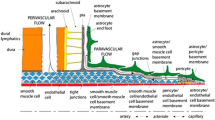Summary
Longitudinal flow through channels with protuberant wall structures such as brushborders were studied both experimentally and theoretically. The experiments were performed using tubes with synthetic internal brushborders, scaled to resemble the geometry and flow in proximal tubules of the kidney. Fractional flow rates in the brushborder were deduced from transit times of dye traces through the central core and total flow rate. The measured ratios of brushborder to core flowQ B /Q C were found to be independent of Reynolds number over the rangeRe=0.01–0.2. They agreed reasonably well with theoretical predictions based on the Kozeny-Carman equation for flow through arrays of parallel cylinders. The predictions can be extended to arbitrary geometries and turbulent flow conditions by appropriate modifications. Extrapolation of the results to the proximal tubule of the kidney indicate that brushborder flowrates there vary from 0.003 to 0.09% of total flow. Any axial transport in these structures would be predominantly diffusive in nature, and would be highly unlikely to affect radial brushborder gradients and transmural flux.
Similar content being viewed by others
References
Baker, D.J. 1968. A technique for the precise measurement of small fluid velocities.J. Fluid Mech. 26 (3):573–575
Bird, R.B., Stewart, W.E., Lightfood, E.N. 1960. Transport Phenomena. p. 200, John Wiley & Sons, New York
De Wardener, H.E. 1978. The control of sodium excretion.Am. J. Physiol. 235:F163-F173
Giebisch, E. 1978. The proximal nephron.In: Physiology of Membrane Disorders. T.E. Andreoli, J.F. Hoffman, and D.D. Fanestil, editors. p. 697, Plenum Medical
Happel, J., Brenner, H. 1965. Low Reynolds Number Hydrodynamics. pp. 392–399, Prentice-Hall, Englewood Cliffs
Marshall, E.A., Trowbridge, E.A. 1974. Flow of a Newtonian fluid through a permeable tube. The application to the proximal renal tubule.Bull. Math. Biol. 36:457–475
Passow, H. 1967. Steady-stage diffusion of non-electrolytes through epithelial brushborders.J. Theoret. Biol. 17:383–398
Richardson, I.W., Likko, V., Bartoli, E. 1973. The nature of passive flows through tightly folded membranes. The influence of microstructure.J. Membrane Biol. 11:293–308
Rostgaard, J., Thuneberg, L. 1972. Electron microscopical observations of the brushborder on proximal tubular cells of mammalian kidney.Zeit. Zellforsch. 132:473–496
Welling, L.W., Welling, D.J. 1975. Surface areas of brushborder and lateral cell walls in the rabbit proximal nephron.Kidney Int. 8:343–348
Author information
Authors and Affiliations
Rights and permissions
About this article
Cite this article
Basmadjian, D., Dykes, D.S. & Baines, A.D. Flow through brushborders and similar protuberant wall structures. J. Membrain Biol. 56, 183–190 (1980). https://doi.org/10.1007/BF01869475
Received:
Revised:
Issue Date:
DOI: https://doi.org/10.1007/BF01869475




